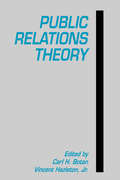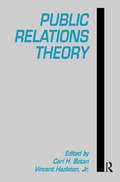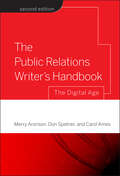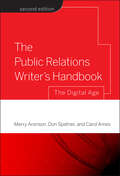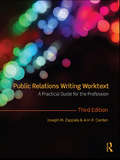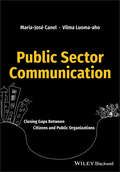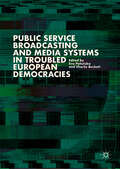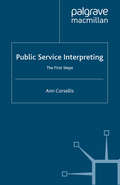- Table View
- List View
Public Relations Theory
by Carl H. BotanBeginning with the basic premise that public relations can best be understood as a specialized type of communication, the contributors to this volume establish public relations as a vital and viable realm for communication research and theory development. Through the application of communication theories, they attempt to explain and predict public relations practices and then use these practices to develop communication theories. Their discussions fall into three distinct categories: metatheory, theory, and examples of applications of theories. An ideal volume for professionals and students in communication, journalism, and related fields.
Public Relations Theory
by Carl H. BotanBeginning with the basic premise that public relations can best be understood as a specialized type of communication, the contributors to this volume establish public relations as a vital and viable realm for communication research and theory development. Through the application of communication theories, they attempt to explain and predict public relations practices and then use these practices to develop communication theories. Their discussions fall into three distinct categories: metatheory, theory, and examples of applications of theories. An ideal volume for professionals and students in communication, journalism, and related fields.
Public Relations Theory (Routledge Communication Ser.)
by Carl H. Botan Vincent HazletonBeginning with the basic premise that public relations can best be understood as a specialized type of communication, the contributors to this volume establish public relations as a vital and viable realm for communication research and theory development. Through the application of communication theories, they attempt to explain and predict public relations practices and then use these practices to develop communication theories. Their discussions fall into three distinct categories: metatheory, theory, and examples of applications of theories. An ideal volume for professionals and students in communication, journalism, and related fields.
Public Relations Theory II (Routledge Communication Series)
by Carl H. Botan Vincent HazletonThe public relations landscape has changed dramatically from what it was in 1989, when the original Public Relations Theory volume was published. Reflecting the substantial shifts in the intervening years, Public Relations Theory II, while related to the first volume, is more a new work than a revision. Editors Carl H. Botan and Vincent Hazleton have brought together key theorists and scholars in public relations to articulate the current state of public relations theory, chronicling the ongoing evolution of public relations as a field of study. The contributors to this volume represent the key figures in the discipline, and their chapters articulate the significant advances in public relations theory and research.Working from the position that public relations is a theoretically grounded and research based discipline with the potential to bring numerous areas of applied communication together, Botan and Hazleton have developed this volume to open up the public relations field to a broad variety of theories. Organized into two major sections--Foundations, and Tools for Tomorrow--the volume presents four types of chapters: discussions addressing how public relations should be understood and practiced; examinations of theories from other areas applied to public relations; explorations of theories about a specific area of public relations practice; and considerations of public relations theories and research that have not been given sufficient attention in the past or that hold particular promise for the future of public relations. It serves as a thorough overview of the current state of theory in public relations scholarship. Like its predecessor, Public Relations Theory II will be influential in the future development of public relations theory. Taken as a whole, the chapters in this book will help readers develop their own sense of direction for public relations theory. Public Relations Theory II is an essential addition to the library of every public relations scholar, and is appropriate for use in advanced public relations theory coursework as well as for study and reference.
Public Relations Theory II (Routledge Communication Series)
by Carl H. Botan Vincent HazletonThe public relations landscape has changed dramatically from what it was in 1989, when the original Public Relations Theory volume was published. Reflecting the substantial shifts in the intervening years, Public Relations Theory II, while related to the first volume, is more a new work than a revision. Editors Carl H. Botan and Vincent Hazleton have brought together key theorists and scholars in public relations to articulate the current state of public relations theory, chronicling the ongoing evolution of public relations as a field of study. The contributors to this volume represent the key figures in the discipline, and their chapters articulate the significant advances in public relations theory and research.Working from the position that public relations is a theoretically grounded and research based discipline with the potential to bring numerous areas of applied communication together, Botan and Hazleton have developed this volume to open up the public relations field to a broad variety of theories. Organized into two major sections--Foundations, and Tools for Tomorrow--the volume presents four types of chapters: discussions addressing how public relations should be understood and practiced; examinations of theories from other areas applied to public relations; explorations of theories about a specific area of public relations practice; and considerations of public relations theories and research that have not been given sufficient attention in the past or that hold particular promise for the future of public relations. It serves as a thorough overview of the current state of theory in public relations scholarship. Like its predecessor, Public Relations Theory II will be influential in the future development of public relations theory. Taken as a whole, the chapters in this book will help readers develop their own sense of direction for public relations theory. Public Relations Theory II is an essential addition to the library of every public relations scholar, and is appropriate for use in advanced public relations theory coursework as well as for study and reference.
Public Relations Theory III: In the Age of Publics (Routledge Communication Series)
by Carl H. Botan Erich J. SommerfeldtThis important book chronicles, responds to, and advances the leading theories in the public relations discipline. Taking up the work begun by the books Public Relations Theory and Public Relations Theory II, this volume offers completely original material reflecting public relations as practiced today. It features contributions by leading public relations researchers from around the world who write about new developments in the field. Important subjects include: a turn to more humanistic, social, dialogic, and cocreational perspectives on public relations; changes in the capacity and use of new information technologies; a greater emphasis on non-Western international and intercultural public relations that considers an increasingly politically polarized culture; and issues of ethics that look beyond how clients and the traditional mass media are treated and into much broader questions of voice, agency, race, identity, and the economic and political status of publics. This book is a touchstone for advanced undergraduate and graduate courses in public relations theory and a key reference for researchers.
Public Relations Theory III: In the Age of Publics (Routledge Communication Series)
by Carl H. Botan Erich J. SommerfeldtThis important book chronicles, responds to, and advances the leading theories in the public relations discipline. Taking up the work begun by the books Public Relations Theory and Public Relations Theory II, this volume offers completely original material reflecting public relations as practiced today. It features contributions by leading public relations researchers from around the world who write about new developments in the field. Important subjects include: a turn to more humanistic, social, dialogic, and cocreational perspectives on public relations; changes in the capacity and use of new information technologies; a greater emphasis on non-Western international and intercultural public relations that considers an increasingly politically polarized culture; and issues of ethics that look beyond how clients and the traditional mass media are treated and into much broader questions of voice, agency, race, identity, and the economic and political status of publics. This book is a touchstone for advanced undergraduate and graduate courses in public relations theory and a key reference for researchers.
Public Relations und Kommunikationsmanagement: Eine medienwissenschaftliche Grundlegung (Organisationskommunikation)
by Lars RademacherPublic Relations und Legitimität: Der Beitrag des organisationalen Neo-Institutionalismus für die PR-Forschung (Organisationskommunikation)
by Swaran SandhuOrganisationen aller Art stehen durch die öffentliche Beobachtung – z. B. durch Medien, Politik oder gesellschaftliche Gruppen – immer stärker unter einem Zwang, ihre Aktivitäten zu rechtfertigen. Sie reagieren darauf häufig mit Public Relations (PR), die dadurch stark an Bedeutung gewinnt. Doch wie lässt sich dieser Zugewinn an Geltung erklären? Aus einer institutionellen Perspektive rückt ein Kernbegriff der PR ins Zentrum: organisationale Legitimität. Der organisationale Neo-Institutionalismus stellt der PR-Forschung an dieser Stelle neue Modelle zur Verfügung. Sie können erklären, wie Organisationen ihre Legitimität mit kommunikativen Mitteln aufbauen, erhalten oder verteidigen. PR ist aus der institutionellen Perspektive weniger das Ergebnis eines funktionalen Kommunikationsmanagements als vielmehr die Folge gesellschaftlicher Erwartungsstrukturen.
Public Relations und Wirtschaftsjournalismus: Erfolgs- und Risikofaktoren für einen win-win (Organisationskommunikation)
by Torsten KnödlerPressesprecher und Wirtschaftsjournalisten sind aufeinander angewiesen. Das Miteinander der beiden Akteursgruppen changiert dabei zwischen Duett und Duell. Doch wie verläuft die Interaktion von Pressesprechern und Wirtschaftsjournalisten wirklich? Welche Erwartungen existieren in bestimmten Situationen? Die Kernfrage lautet: Welche konkreten Erfolgs- und Risikofaktoren gibt es bei der Zusammenarbeit von Pressesprechern und Wirtschaftsjournalisten im Zeitablauf? Torsten Knödler leuchtet mit Hilfe eines innovativen Forschungsdesigns (Cross-Double-Delphi) und eines integrativen Theoriemodells (u.a. Spieltheorie, Quadrantenmodell, Intereffikationsmodell) aus, was Wirtschaftsjournalisten von Pressesprechern erwarten und umgekehrt. Dabei analysiert er die Phasen Anbahnung, Verlauf und Krise und gibt konkrete Handlungsempfehlungen.
Public Relations von Finanzorganisationen: Ein Praxishandbuch für die externe und interne Kommunikation
by Jörg E. Allgäuer Matthias LarischDie Öffentlichkeitsarbeit von Finanzorganisationen unterscheidet sich deutlich von der anderer Unternehmen. Die Gründe hierfür liegen in den Besonderheiten der angebotenen Produkte und Dienstleistungen, in der volkswirtschaftlichen Rolle und gegenseitigen Verflechtung von Finanzorganisationen, in der hohen Regulierungsdichte und in den Eigenheiten der Finanzberichterstattung. „Public Relations von Finanzorganisationen“ bietet eine praxisorientierte und gleichzeitig theoretisch abgesicherte Grundlage für die Kommunikation von Finanzorganisationen. Die Autoren erklären die wesentlichen Bereiche der Finanz-PR für alle Zielgruppen (Mitarbeiter, Medien, Aktionäre, Geschäftspartner, politische Entscheidungsträger und Gesellschaft) und stellen dabei die strategischen und operativen Besonderheiten in der Kommunikation heraus. Über 500 konkrete Tipps, zahlreiche Infoboxen, Abbildungen und Mustervorlagen sowie aktuelle Brancheninterviews zeugen vom hohen Praxisgehalt dieses Kompendiums.
The Public Relations Writer's Handbook: The Digital Age
by Merry Aronson Don Spetner Carol AmesThe second edition of the Public Relations Writer’s Handbook offers a simple, step-by-step approach to creating a wide range of writing, from basic news releases, pitch letters, biographies, and media alerts, to more complex and sophisticated speeches, media campaign proposals, crisis responses, and in-house publications. In addition, the thoroughly expanded and updated second edition shows how to keep up with the best practices of the public relations profession, as well as with the speed made possible and required by the digital age.
The Public Relations Writer's Handbook: The Digital Age
by Merry Aronson Don Spetner Carol AmesThe second edition of the Public Relations Writer’s Handbook offers a simple, step-by-step approach to creating a wide range of writing, from basic news releases, pitch letters, biographies, and media alerts, to more complex and sophisticated speeches, media campaign proposals, crisis responses, and in-house publications. In addition, the thoroughly expanded and updated second edition shows how to keep up with the best practices of the public relations profession, as well as with the speed made possible and required by the digital age.
The Public Relations Writer’s Handbook
by Whitney LehmannFrom pitches and press releases to news and feature stories to social media writing and more, this new book by author Whitney Lehmann and a handful of experienced contributors breaks down the most widely used types of public relations writing needed to become a PR pro. The Public Relations Writer&’s Handbook serves as a guide for those both in the classroom and in the field who want to learn, and master, the style and techniques of public relations writing. Eighteen conversational chapters provide an overview of the most popular forms of public relations writing, focusing on media relations, storytelling, writing for the web/social media, business and executive communications, event planning and more. Chapters include user-friendly writing templates, exercises and AP Style skill drills and training. Whether you&’re a PR major or PR practitioner, this book is for you. Lehmann has combined her industry and classroom experience to create a handbook that&’s accessible for PR students and practitioners alike. A dedicated eResource also supports the book, with writing templates and answer keys (for instructors) to the end-of-chapter exercises in the text. www.routledge.com/9780815365280.
The Public Relations Writer’s Handbook
by Whitney LehmannFrom pitches and press releases to news and feature stories to social media writing and more, this new book by author Whitney Lehmann and a handful of experienced contributors breaks down the most widely used types of public relations writing needed to become a PR pro. The Public Relations Writer&’s Handbook serves as a guide for those both in the classroom and in the field who want to learn, and master, the style and techniques of public relations writing. Eighteen conversational chapters provide an overview of the most popular forms of public relations writing, focusing on media relations, storytelling, writing for the web/social media, business and executive communications, event planning and more. Chapters include user-friendly writing templates, exercises and AP Style skill drills and training. Whether you&’re a PR major or PR practitioner, this book is for you. Lehmann has combined her industry and classroom experience to create a handbook that&’s accessible for PR students and practitioners alike. A dedicated eResource also supports the book, with writing templates and answer keys (for instructors) to the end-of-chapter exercises in the text. www.routledge.com/9780815365280.
Public Relations Writing Worktext: A Practical Guide for the Profession
by Ann R. Carden Joseph M. ZappalaPublic Relations Writing Worktext provides the fundamental knowledge and the basic preparation required for the professional practice of public relations writing. This textbook introduces readers to public relations and writing, providing an overview of the four-step public relations process in addition to defining and detailing the writing activities involved. It presents in-depth information on the writing formats and approaches used in implementing strategic public relations plans, and offers instruction for developing all types of writing assignments, starting with memos, proposals, and news releases, and moving on to the more complex tasks of advocacy writing, newsletters, crisis planning, and online communication. Examples accompany the discussions, providing guidance and structure for the varied writing activities. Retaining the approach of the second edition, this text incorporates numerous changes and updates, making it suitable for use as a primary course text. Updates include: increased focus on writing for the web, blogs, and electronic media, including information on writing social media releases and a new chapter entitled "New and Social Media" a new planning outline to help writers develop more effective messages expanded checklists for writers to reference when working on assignments additional examples of effective public relations writing by leading companies in a variety of organizational settings, including Mattel, UPS, Burger King, Sara Lee, Xerox, Frito-Lay, and many more new assignments based on topics, issues and problems that public relations professionals in all sectors face today restructured content for improved writing flow and consistency full instructor manual available at www.routledge.com/textbooks/zappala Authors Joseph M. Zappala and Ann R. Carden offer a clear and engaging introduction to the writing activities involved in public relations practice, resulting in a valuable resource for professionals as well as a practical classroom text for students planning careers in public relations.
Public Relations Writing Worktext: A Practical Guide for the Profession
by Joseph M. ZappalaPublic Relations Writing Worktext provides the fundamental knowledge and the basic preparation required for the professional practice of public relations writing. This textbook introduces readers to public relations and writing, providing an overview of the four-step public relations process in addition to defining and detailing the writing activities involved. It presents in-depth information on the writing formats and approaches used in implementing strategic public relations plans, and offers instruction for developing all types of writing assignments, starting with memos, proposals, and news releases, and moving on to the more complex tasks of advocacy writing, newsletters, crisis planning, and online communication. Examples accompany the discussions, providing guidance and structure for the varied writing activities. Retaining the approach of the second edition, this text incorporates numerous changes and updates, making it suitable for use as a primary course text. Updates include: increased focus on writing for the web, blogs, and electronic media, including information on writing social media releases and a new chapter entitled "New and Social Media" a new planning outline to help writers develop more effective messages expanded checklists for writers to reference when working on assignments additional examples of effective public relations writing by leading companies in a variety of organizational settings, including Mattel, UPS, Burger King, Sara Lee, Xerox, Frito-Lay, and many more new assignments based on topics, issues and problems that public relations professionals in all sectors face today restructured content for improved writing flow and consistency full instructor manual available at www.routledge.com/textbooks/zappala Authors Joseph M. Zappala and Ann R. Carden offer a clear and engaging introduction to the writing activities involved in public relations practice, resulting in a valuable resource for professionals as well as a practical classroom text for students planning careers in public relations.
Public Sector Communication: Closing Gaps Between Citizens and Public Organizations (Handbooks In Communication And Media Ser.)
by María José Canel Vilma Luoma-ahoA comprehensive guide to future-proofing public sector communication and increasing citizen satisfaction How to communicate with the citizens of the future? Why does public sector communication often fail? Public Sector Communication combines practical examples from around the world with the latest theoretical insights to show how communication can help bridge gaps that exist between public sector organizations and the individual citizens they serve. The authors—two experts in the field with experience from the public sector—explain how public entities, be they cities, governments, foundations, agencies, authorities, municipalities, regulators, military, or government monopolies and state owned businesses can build their intangible assets to future-proof themselves in a volatile environment. The book examines how the recent digitalization has increased citizen expectations and why one-way communication leaves public sector organizations fragile. To explain how to make public sector communication antifragile, the authors map contributions from a wide variety of fields combined with illustrative examples from around the world. The authors propose a research-based framework of different intangible assets that can directly improve communication in the public sector. This important resource: Helps explain the sector-specific conditions and why communication is often challenging in the public sector Summarizes all relevant literature on the topic across disciplines and includes the most popular management ideals of the recent decades Explores how public sector organizations can increase citizen satisfaction with effective communication Presents new approaches to both the study and practice of communication in the public sector Provides international examples of successful public sector communication Offers realistic guides to building intangible assets in practice Written for advanced undergraduate and graduate students, as well as public managers and leaders, Public Sector Communication offers an illustrative, research-based guide to improving communication and engaging citizens of today and the future.
Public Sector Communication: Closing Gaps Between Citizens and Public Organizations
by María José Canel Vilma Luoma-ahoA comprehensive guide to future-proofing public sector communication and increasing citizen satisfaction How to communicate with the citizens of the future? Why does public sector communication often fail? Public Sector Communication combines practical examples from around the world with the latest theoretical insights to show how communication can help bridge gaps that exist between public sector organizations and the individual citizens they serve. The authors—two experts in the field with experience from the public sector—explain how public entities, be they cities, governments, foundations, agencies, authorities, municipalities, regulators, military, or government monopolies and state owned businesses can build their intangible assets to future-proof themselves in a volatile environment. The book examines how the recent digitalization has increased citizen expectations and why one-way communication leaves public sector organizations fragile. To explain how to make public sector communication antifragile, the authors map contributions from a wide variety of fields combined with illustrative examples from around the world. The authors propose a research-based framework of different intangible assets that can directly improve communication in the public sector. This important resource: Helps explain the sector-specific conditions and why communication is often challenging in the public sector Summarizes all relevant literature on the topic across disciplines and includes the most popular management ideals of the recent decades Explores how public sector organizations can increase citizen satisfaction with effective communication Presents new approaches to both the study and practice of communication in the public sector Provides international examples of successful public sector communication Offers realistic guides to building intangible assets in practice Written for advanced undergraduate and graduate students, as well as public managers and leaders, Public Sector Communication offers an illustrative, research-based guide to improving communication and engaging citizens of today and the future.
Public Service Broadcasting (Key Concerns in Media Studies)
by David HendyChallenging the opinion that public service broadcasting is a thing of the past, David Hendy explains its importance in the present – and in the future. Written by a leading expert in the field, this book explores the development of public service broadcasting, outlining the key debates and issues, while situating them within wider cultural contexts. Hendy uses media history to consider the outlook for broadcasters such as the BBC, and other networks and stations around the world. He analyzes how these institutions shape society, culture, and politics, focusing on how key ethical and cultural values - such as enlightenment, impartiality, service, choice, and trust – have been constantly reinvented to ensure that broadcasting can carry on being a public 'good' as well as a commercial product. Clear, concise, and contemporary, Public Service Broadcasting is invaluable reading for all students of media and broadcasting, and for anyone interested in a strand of media that has had - and continues to have - an enormous social and cultural impact, not only in Britain, but across the globe.
Public Service Broadcasting (Key Concerns in Media Studies)
by David HendyChallenging the opinion that public service broadcasting is a thing of the past, David Hendy explains its importance in the present – and in the future. Written by a leading expert in the field, this book explores the development of public service broadcasting, outlining the key debates and issues, while situating them within wider cultural contexts.Hendy uses media history to consider the outlook for broadcasters such as the BBC, and other networks and stations around the world. He analyzes how these institutions shape society, culture, and politics, focusing on how key ethical and cultural values - such as enlightenment, impartiality, service, choice, and trust – have been constantly reinvented to ensure that broadcasting can carry on being a public 'good' as well as a commercial product.Clear, concise, and contemporary, Public Service Broadcasting is invaluable reading for all students of media and broadcasting, and for anyone interested in a strand of media that has had - and continues to have - an enormous social and cultural impact, not only in Britain, but across the globe.
Public Service Broadcasting and Media Systems in Troubled European Democracies
by Charlie Beckett Eva PołońskaThis book provides the most recent overview of media systems in Europe. It explores new political, economic and technological environments and the challenges they pose to democracies and informed citizens. It also examines the new illiberal environment that has quickly embraced certain European states and its impact on media systems, considering the sources and possible consequences of these challenges for media industries and media professionals. Part I examines the evolving role of public service media in a comparative study of Western, Southern and Central Europe, whilst Part II ventures into Europe’s periphery, where media continues to be utilised by the state in its quest for power. The book also provides an insight into the role of the European Union in preserving the independence and neutrality of public service media. It will be useful to students and researchers of political communication and international and comparative media, as well as democracy and populism.
Public Service Interpreting: The First Steps (Palgrave Studies in Translating and Interpreting)
by A. CorsellisPublic Service Interpreting is a field of central interest to those involved in ensuring access to public services. This book provides an overview of current issues through a multi-faceted approach, situating the work of public service interpreters in the broader context of public service practice.
Public Service Liberalism: Telecommunications and Transitions in Public Policy
by Alan StoneIdentifying a form of government intervention in social and economic affairs called public service liberalism, Alan Stone looks to that ideology to confront the problems of the 1990s and beyond. He shows in this fascinating case study that the policy has been effective in the past: the American telephone industry from its inception until 1934 is an illustration of how public service liberalism served both economic efficiency and a complex structure of public values. Stone depicts the stages by which public service liberalism was replaced by less adequate policies and suggests ways that it could be successfully restored. Furthermore, Stone demonstrates that government-business relationships like the one that prevailed in the telephone industry were common in the nineteenth and the early twentieth century. He argues that this period was not an era of laissez-faire, as is often alleged, but that its economic energy and extraordinary technological progress were accompanied by complete acceptance of certain kinds of government intervention. Challenging the presuppositions not only of the new ideologists of deregulation, privatization, and competition but also of the practitioners of what he calls the "sanctimonious muddle" of present-day liberalism, Stone demonstrates that public service liberalism could help resolve current problems, such as those in the savings and loan institutions and the cable television industry.Originally published in 1991.The Princeton Legacy Library uses the latest print-on-demand technology to again make available previously out-of-print books from the distinguished backlist of Princeton University Press. These editions preserve the original texts of these important books while presenting them in durable paperback and hardcover editions. The goal of the Princeton Legacy Library is to vastly increase access to the rich scholarly heritage found in the thousands of books published by Princeton University Press since its founding in 1905.
